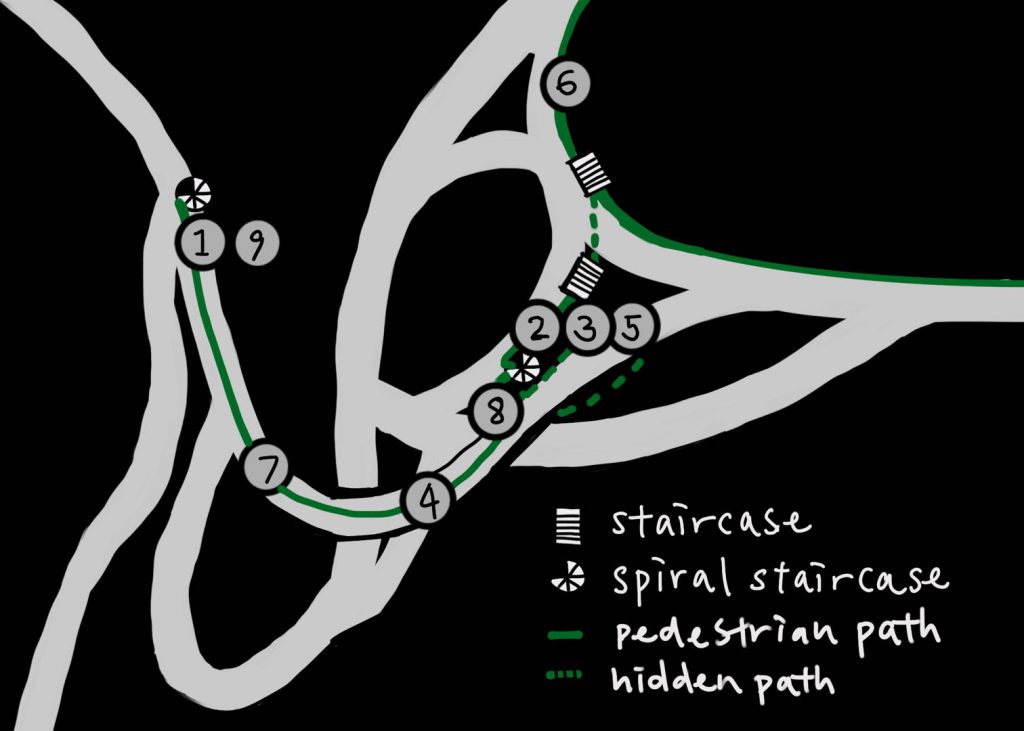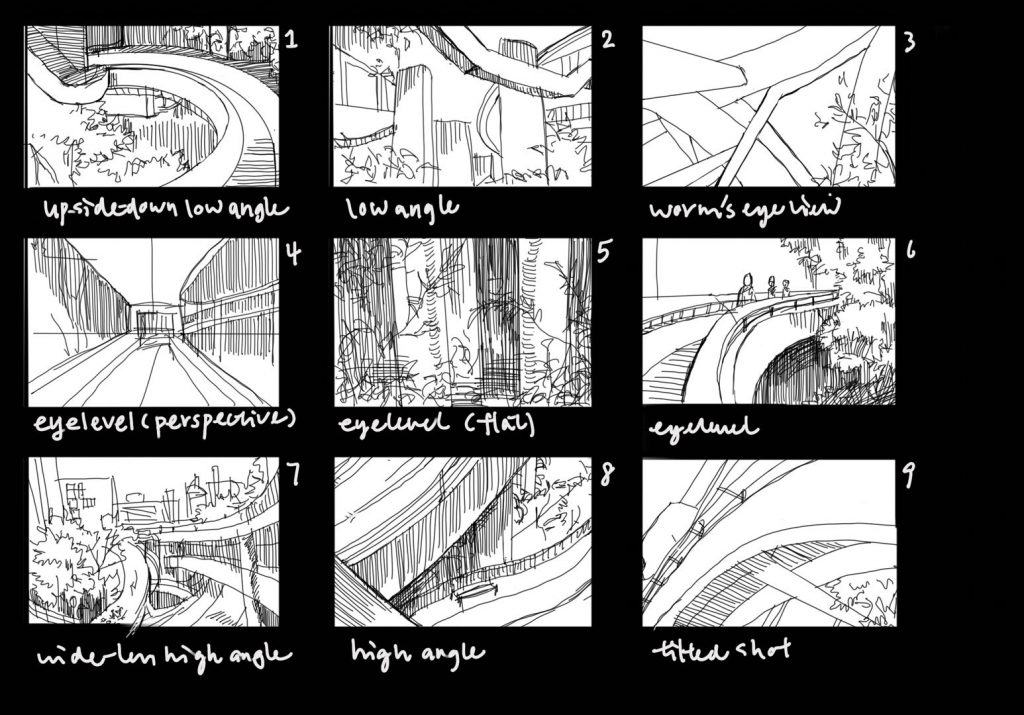Hong Kong’s traffic construction is heavily used. There are 1447 flyovers and bridges and 1583 footbridges and subways to maintain the city’s mobility in dense development and challenging terrain (Highways Department, 2022). This video essay documents the investigation into the Glenealy flyover complex at the Robinson Road-Glenealy-Old Peak Road junction in East Hong Kong Island.
Theme, Setting and Components
Layering traffic construction, vertically segregating and integrating vehicles and pedestrians, create distinctive realms in urban spaces, bustling and tranquil. These juxtapositions occur throughout the fieldwork along the walk in the Glenealy flyover complex, as it allows pedestrians to walk along, above, and beneath the traffic. On the top layer of the flyover complex where the busiest traffic runs, the audio comprises vehicle engines’ noises. As the pedestrians walk down the staircase, along the footbridge beneath Robinson Road to the sidewalk that leads to the lower-level and ends at the spiral staircase, they hear the birds chirping and trees blowing. The upward staircase leads to the longer footbridge where people can sense quakes from trucks passing the overlying road. The downward staircase guides them to the hidden path embedded in tracts of greenery. The layering of roads for traffic and pedestrian, components such as piers, abutments, girders, staircases, and the surrounding environment are the main characters in the film being manipulated in angles and perspectives to frame the construction.
Relevant Library Research
The earliest publication on the Glenealy flyover complex is from South China Morning Post (1976), providing detailed information on junction locations and the expected completion date of the project and its associated system of “grade-separated pedestrian walkways” (6). The research based on the Glenealy flyover complex focuses on the utilization of layered traffic network construction, the contrast between industrialized urban spaces and residual ecological environment, and the spatial interrelation between traffic, pedestrian, and construction.
In Chan’s dissertation (1996) on flyover planning, she defines flyovers, similar to bridges, to provide passageways for transport to take place over an otherwise inaccessible area. Nevertheless, Chan notes the inadequate use of space under traditional flyover structures. A Flyover complex, compared to bridges with unusable or unpassable space beneath, is considered to have higher functionality by allowing multiple strands of traffic to cross over or to run in parallel.
Video Production Techniques
As mentioned above, publications such as historical newspapers and official documents are the foundation of the research, as the construction can be traced from past to present. Moreover, online sources contribute to footage preparation. The mise en scene concept fosters the development of video production: the contrast between nature, construction, and human beings created from the combination of compositions, framings, and camera movements (Matt, 2023). Another article from Nashville Film Institute (2023) on montage determined the form of the video essay as the idea of “constructing a gestalt” (6) from putting multiple images and upbringings together echoes with the message in the investigation: how components of the Glenealy flyover complex are segregated and integrated at the same time. Several cinematography techniques practiced in the video essay include angle shots (high/low/eye angle, worm’s eye view, and tilted shot), camera movements (static, zoom, pan, tilt, and roll), time-lapse, close-up and wide shots. In the editing process, the original audio is kept and denoised to provide an immersive auditory presentation to the audience without distraction from background music or voice-over. On-screen text is provided to guide the audience through the narration.
Fieldwork Reflections
The video production has a paucity of prior planning not only due to limitations in time but also the difficulty in producing a storyboard without pre-visiting the location. The Glenealy flyover complex is a large construction with an intricate layout, which pressures making cinematography decisions on composition and framing during the fieldwork, mostly improvisation. Fortunately, the site comprises numerous details and sceneries that evoke a more comprehensive interpretation and creativity of compositions. The initial storyboard is revised with plenty of additional unexpected shots and rearranged to build up the narration. Apart from planning, the film could have been enhanced with more articulate narration to improve storytelling rather than narrating in flat, straightforward documentary form. The order of sequences and collection of scenes and transitions could have been planned more carefully. The order of shots in the video essay neither complies with the fieldwork route (6-5-7-1-9-4-8-2-3) nor is consistent with the order in the storyboard (categorized into different camera angles and subject matters). Despite these minor drawbacks in video production, the investigation is pleasantly surprising as the flyover complex enables experiments on compositions, and nearby pedestrians and traffic add to the content to make a more vivid depiction of the Glenealy flyover complex.


Xie Jingni (3036104307)
Bibliography
“$14m Flyover Complex Planned for Mid-Levels.” South China Morning Post (1946-), Jul 30, 1976, http://eproxy.lib.hku.hk/login?url=https://www.proquest.com/historical-newspapers/14m-flyover-complex-planned-mid-levels/docview/1529415855/se-2 (accessed May 6, 2023).
Carrole, Barrie O. “28 Composition Techniques That Will Improve Your Photos.” PetaPixel, February 15, 2023. https://petapixel.com/photography-composition-techniques/.
Chan, Sui-mui, Joan. “Utilizes Vacant Space Around the Flyover”. University of Hong Kong, 1996.
DeGuzman, Kyle. “Watch: Ultimate Guide to Camera Movement: When & How to Use Camera Movement… Explained.” StudioBinder, February 1, 2021. https://www.studiobinder.com/blog/different-types-of-camera-movements-in-film/#camera-movements-static-shot-definition.
“Easing the Mid – Levels Traffic Chaos.” South China Morning Post (1946-), Sep 15, 1977, http://eproxy.lib.hku.hk/login?url=https://www.proquest.com/historical-newspapers/easing-mid-levels-traffic-chaos/docview/1538917597/se-2 (accessed May 6, 2023).
“Fact Sheets.” Highways Department – Fact Sheets. Accessed May 6, 2023. https://www.hyd.gov.hk/en/information_corner/hyd_factsheets/index.html.
Google Maps. “Glenealy Footbridge, Hong Kong.” Accessed May 7, 2023.
Matt. “What Is Mise En Scène in Film: The Complete Guide • Filmmaking Lifestyle.” Filmmaking Lifestyle, January 12, 2023. https://filmlifestyle.com/what-is-mise-en-scene-in-film/.
Nashville Film Institute. “Montage – Everything You Need to Know.” NFI, March 9, 2023. https://www.nfi.edu/montage/#:~:text=To%20make%20the%20most%20of%20the%20montage%20effect%2C,Music%204%20Voiceover%205%20Camera%20movement%206%20Juxtaposition.
The lack of background music in the video initially strikes me as extremely strange, but I soon realize that the ambient noises help me to focus more on the textures and images themselves. I really appreciate how the storyboard outlines the structure and sequence of how the architecture will be presented. The way the screen is divided by the bridges and trees creates a very aesthetically pleasing and charming sense throughout the entire scene. In addition, I really recognize how you contrasted the static and motion in the image to draw attention to the various architectural elements, such as the piers, abutments, girders, and staircases that you mentioned. However, it also highlights the interaction between traffic, architecture, and pedestrians at the same time. It’s important to note that the upside-down scene really captures the aesthetic structure of the bridge and is the one that makes me feel the most. The essay’s overall structure and organization are clear, and the way the research was conducted, how it was done, and what was discovered—along with any minor flaws that needed to be fixed—are all described in a way that makes it simple for readers to understand. At the same time, creativity strikes a good balance with the significance of the discovery and offers readers new perspectives.
This is a well-round deconstruction of a specific piece of infrastructure from which interpretations beyond expectations are produced. I find the idea of vertical segregation exceptionally provocative—how different layers of the flyover complex comprise distinctive visual and auditory components. The video has done a fascinating job of generating a sense of contrast between perspectives with ambient sounds that switch with frames of facilities with different functions. Moreover, an intertwined organization is achieved with shots following the ascending or descending movements through the walkway channels, which I assume can be dedicated to your sophisticated storyboard. The videography techniques involved are highly versatile, and divergences from a typical viewpoint, such as tilted shots, offer an immersive experience. Flaws are merely technical: resolution can be enhanced for better visuals, and the ambiance can benefit from muffed transitions when switching shots. Excellent work!